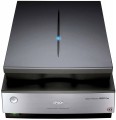Format
—
A0. The largest sheet size specified by the ISO 216 standard is 1189x841 mm (4 times the size of a newspaper spread). It is found exclusively in broaching-type devices (see above), belonging to the professional class.
—
A1. Sheet size 594x841 mm. For a number of reasons, this option has not received much distribution in scanners.
—
A3. Sheet size 297x420 mm, i.e. 2 times larger than the standard landscape. Support for this format allows you to scan quite large materials, such as an entire spread of a magazine or a page of a newspaper, in one pass.
—
A4. Standard landscape sheet 210x297 mm, the most common paper format today, especially in office documentation. Most scanners have this format, it is enough for most personal and work tasks.
—
A5. 148x210 mm, in other words — half of a standard landscape sheet. Scanners for this format are compact, but they are very rare, because. working with the popular A4 format on them is at least inconvenient.
—
A6. 105x148 mm, a quarter of a standard landscape sheet. Such scanners are small in size and are convenient for working with photographs, where the standard print size (10x15 cm) is approximately equal to A6, but today they are almost never used for the same reasons as A5 (see
...above).
Specifies the maximum size allowed for scanning. Note that the actual size of the maximum scan area (see below) may be larger than the paper size specified in the specifications. And in broaching models (see "Type") the size of the processed materials is generally limited only by the width of the scanner. In fact, manufacturers indicate the maximum size in order to make it easier for the user to determine the capabilities of the scanner and its compatibility with popular paper sizes.Max. resolution
The highest resolution of the digital image generated by the scanner during operation. Specified in dots per inch — dpi (dots per inch).
The higher the scan resolution, the higher the resolution of the resulting image will be (with the same size of the source material) and the more accurately small details will be transmitted on it. On the other hand, high resolution noticeably affects the price of the scanner, increases the processing time and the size of the resulting file — despite the fact that the real need for high detail is not always present, and in some cases it is even unnecessary (for example, when processing an image with small artifacts, not visible at low detail). Therefore, when choosing by this parameter, you should not chase high resolution values — you should proceed from the real need and the specifics of the intended use of the scanner.
The simplest modern scanners have a resolution of about 300x300 dpi — this is quite enough for text recognition with an average font size. And in high-end professional models, this figure can exceed 7000x7000 dpi.
Max. scan area
The maximum image size that the scanner can process at one time, both horizontally and vertically. You should pay attention to this parameter if you need the exact dimensions of the scanner's working area, down to a millimetre: although standard formats are used to designate these dimensions (see "Format"), in fact the dimensions may differ from them.
Optical density
The maximum optical density of a dark image that the scanner can distinguish from pure black. Optical density characterizes how much of the light falling on the image was reflected (for opaque images) or transmitted (for transparent). The higher the optical density, the less light the object reflects / transmits. Accordingly, the higher the optical density of the scanner, the higher its sensitivity and the better it is suitable for working with dark images.
Colour depth (ext.)
External colour depth characterizes the maximum possible number of colour shades in the image transmitted by the scanner to the computer. A depth of 24 bits is considered quite enough for non-professional tasks, in more advanced models this parameter can reach 96 bits. For details on colour depths and their relationship, see "Colour Depth (Int.)"
Mono scanning
The black and white scanning speed provided by the device. Usually, the maximum processing speed for an A4 sheet is indicated, i.e. speed at the lowest resolution. In fact, the speed is usually lower and depends on both the resolution and the size of the original material. The higher the scanning speed, the more convenient it is to work with the scanner; pay special attention to this parameter if you plan to work with numerous black and white images.
Colour scanning
Colour scanning speed provided by the device. In fact, it depends on the selected resolution, colour depth and original dimensions; the characteristics most often indicate the speed for an A4 sheet at the minimum resolution and colour depth, i.e. maximum possible speed. If you only need to scan one or more sheets from time to time, high speed is not too critical, but for working with a large amount of materials, you should look for fast models.
Slide module
By default, the scanner is designed to work with reflective, i.e. opaque materials (such as paper).
The slide module allows you to use the device for processing transparent materials, such as photographic film.
Power consumption
The maximum power consumed by the scanner during operation. The higher the power, the more energy the scanner consumes, but this only applies to the scanning process itself — in standby mode, power consumption is negligible. And even at the peak in most models, the power is so low that in fact this parameter has practically no effect on electricity bills and is more of an auxiliary value (for example, it is used to calculate the total power of devices connected to an uninterruptible power supply).

